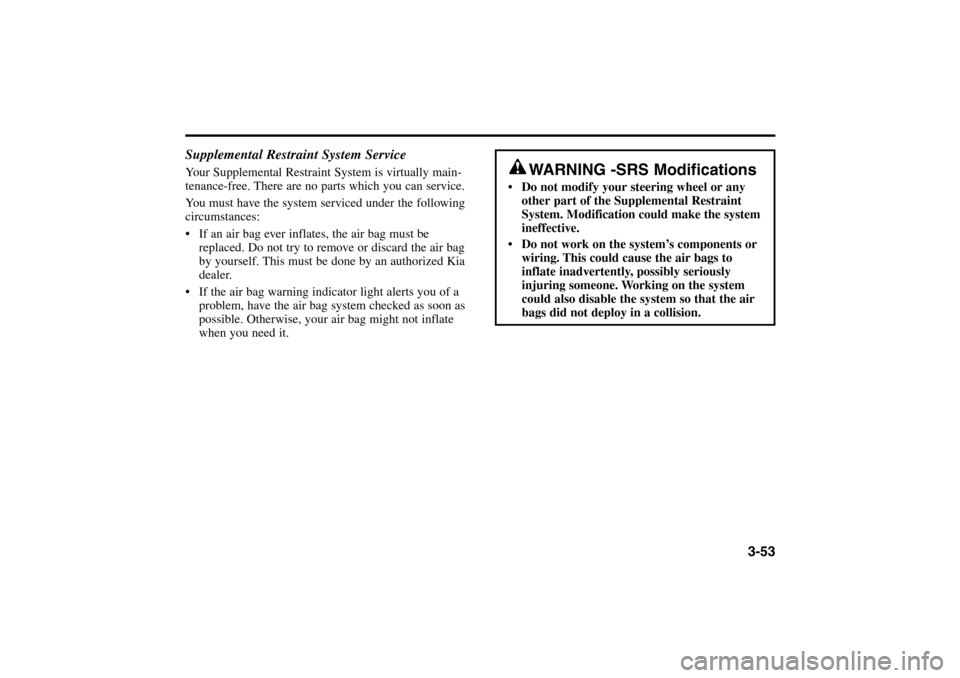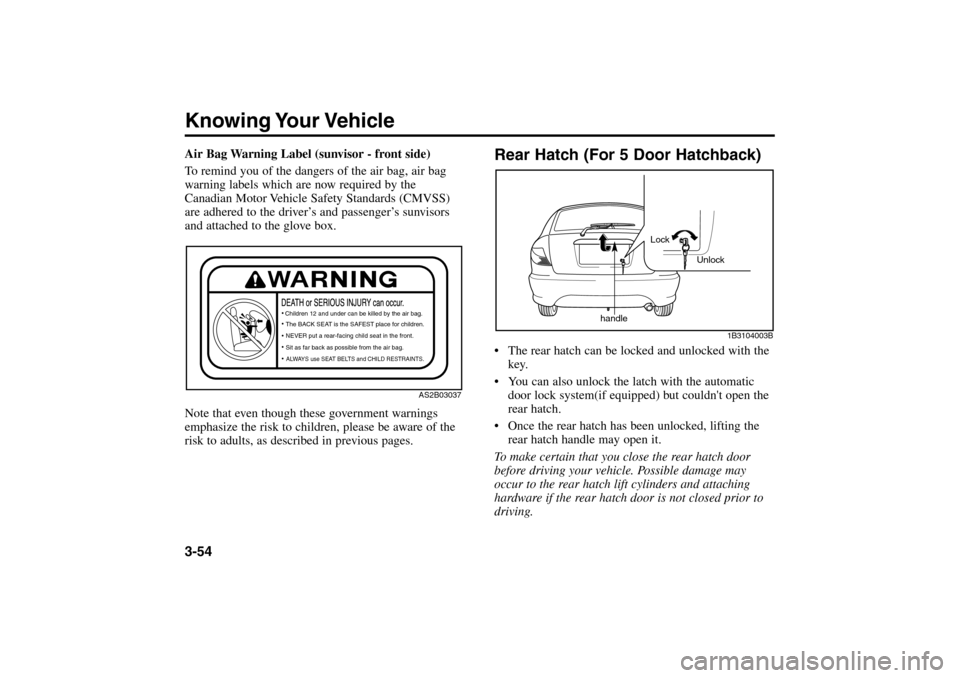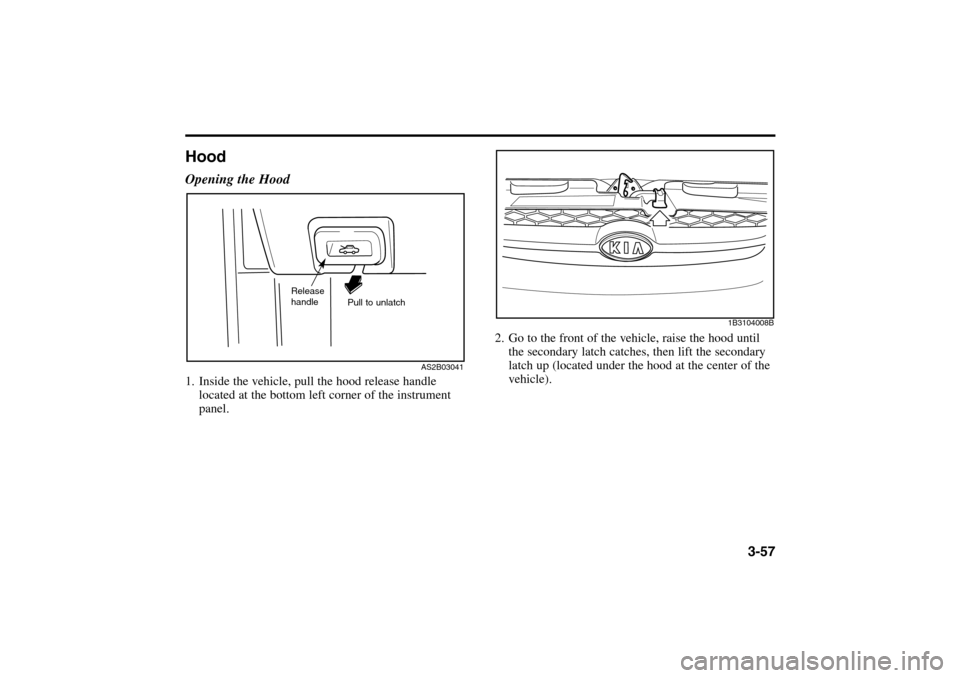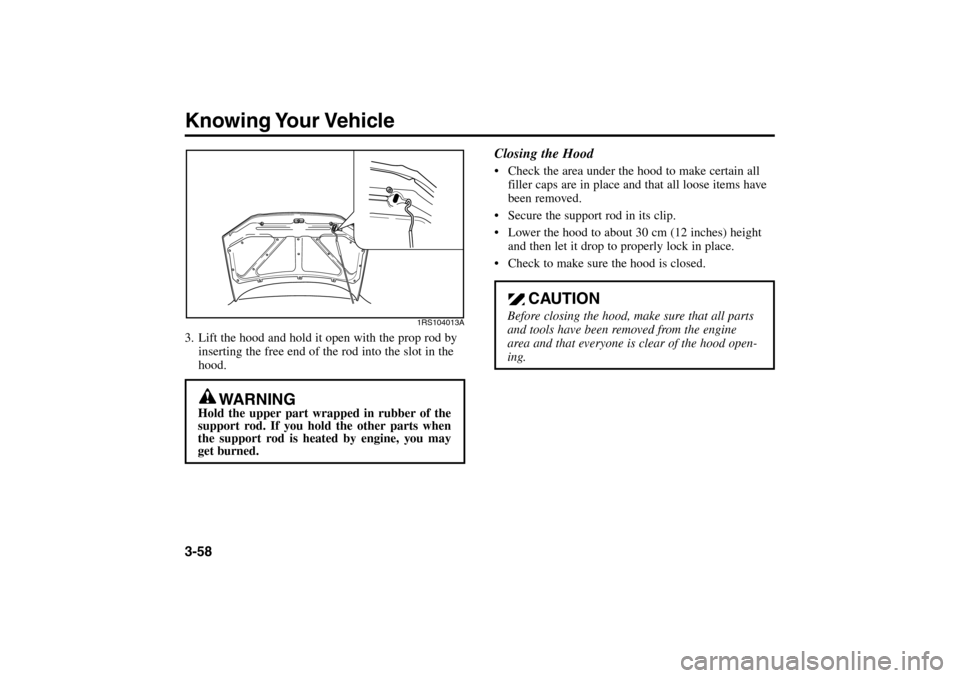KIA Rio 2005 2.G Repair Manual
Manufacturer: KIA, Model Year: 2005, Model line: Rio, Model: KIA Rio 2005 2.GPages: 238, PDF Size: 2.6 MB
Page 61 of 238

3-51 The Importance of The Passenger Being
Properly Seated
The front seat passenger’s air bag is much larger than
the driver’s air bag and inflates with considerably more
force. It can seriously hurt or kill a passenger who is
not in the proper position and wearing the safety belt
properly. The front passenger should always move
their seat as far back as practical and sit well back in
the seat. It is essential that the front passenger always
wears his/her safety belt, even when travelling in a
parking lot or along a driveway into a garage.
1B3102002E
The reason for this is that in most frontal impacts there
is substantial pre-impact braking which tends to throw
the occupants forward. If the right front passenger is
not using their safety belt, they will be directly in front
of or even touching the air bag storage compartment
when inflation occurs. In that situation, death or severe
injury is possible.
Because of the air bag, you must NEVER INSTALL A
CHILD RESTRAINT SYSTEM IN THE FRONT
PASSENGER SEAT. There is a very significant risk of
serious or fatal injuries to a child in a child restraint if
the right front passenger air bag inflates.
WARNING -Right Front Seat
Pre-impact braking could throw an unbelted
passenger toward or onto the air bag storage
compartment. Upon impact in a collision, the
air bag would rapidly inflate and possibly
serverly injure or kill that occupant who failed
to wear their safety belt.
RIO ENG CNA 3.qxd 7/29/05 5:13 PM Page 51
Page 62 of 238

Knowing Your Vehicle3-52 Air Bag Warning LightThe purpose of the air bag warning light in your instru-
ment panel is to alert you of a potential problem with
your Air Bag – Supplemental Restraint System (SRS).
WARNING - Front Passengers
NEVER use a child restraint in the front
seat. There is a very significant risk of seri-
ous or fatal injuries to a child in a child
restraint if the right front passenger air bag
inflates.
In the front seat, a rear-facing child restraint
would be positioned too close to where the
air bags are stored and in the event an air
bag deploys, the air bag would impact the
rear-facing child restraint and cause serious
injuries or death.
Failure to observe the instructions provided
with the child restraint system could
increase the risk and/or severity of injury in
an accident.
Have the system checked if:
The light does not illuminate when you turn the
ignition ON.
The light stays ON after the engine starts.
The light comes ON or flashes while you are dri-
ving.
A-BAG-W
AIR BAG WARNING LIGHT
RIO ENG CNA 3.qxd 7/29/05 5:13 PM Page 52
Page 63 of 238

3-53 Supplemental Restraint System Service
Your Supplemental Restraint System is virtually main-
tenance-free. There are no parts which you can service.
You must have the system serviced under the following
circumstances:
If an air bag ever inflates, the air bag must be
replaced. Do not try to remove or discard the air bag
by yourself. This must be done by an authorized Kia
dealer.
If the air bag warning indicator light alerts you of a
problem, have the air bag system checked as soon as
possible. Otherwise, your air bag might not inflate
when you need it.
WARNING -SRS Modifications
Do not modify your steering wheel or any
other part of the Supplemental Restraint
System. Modification could make the system
ineffective.
Do not work on the system’s components or
wiring. This could cause the air bags to
inflate inadvertently, possibly seriously
injuring someone. Working on the system
could also disable the system so that the air
bags did not deploy in a collision.
RIO ENG CNA 3.qxd 7/29/05 5:13 PM Page 53
Page 64 of 238

Knowing Your Vehicle3-54Air Bag Warning Label (sunvisor - front side)
To remind you of the dangers of the air bag, air bag
warning labels which are now required by the
Canadian Motor Vehicle Safety Standards (CMVSS)
are adhered to the driver’s and passenger’s sunvisors
and attached to the glove box.
Note that even though these government warnings
emphasize the risk to children, please be aware of the
risk to adults, as described in previous pages.
Children 12 and under can be killed by the air bag.
The BACK SEAT is the SAFEST place for children.
NEVER put a rear-facing child seat in the front.
Sit as far back as possible from the air bag.ALWAYS use SEAT BELTS and CHILD RESTRAINTS.
AS2B03037
Rear Hatch (For 5 Door Hatchback) The rear hatch can be locked and unlocked with the
key.
You can also unlock the latch with the automatic
door lock system(if equipped) but couldn't open the
rear hatch.
Once the rear hatch has been unlocked, lifting the
rear hatch handle may open it.
To make certain that you close the rear hatch door
before driving your vehicle. Possible damage may
occur to the rear hatch lift cylinders and attaching
hardware if the rear hatch door is not closed prior to
driving.
1B3104003B
handleUnlock Lock
RIO ENG CNA 3.qxd 7/29/05 5:13 PM Page 54
Page 65 of 238

3-55
Trunk Lid (For 4 Door Coupe) To open the trunk, insert the key into the lock and
turn it clockwise until an audible “click” is heard.
To close the trunk, use both hands to push the trunk
lid down until the lock “snaps’’ shut.
Do not slam the trunk lid.
Pull up on the trunk lid to make sure it is securely
latched.
To prevent premature wear or damage to the trunk lid
lift cylinders and attaching hardware, the trunk lid
must be fully closed before you drive your vehicle.
1B3104007E
Unlock
Key slot
If you must drive with the trunk lid open, keep the air
vents open so that additional outside air comes into the
vehicle.Remote Trunk Lid Release (If Equipped)The release is located at the left front corner of the dri-
ver’s seat on the floor. To open the trunk, pull up on
the lever.
WARNING -Exhaust Fumes
If you drive with the trunk lid open, you will
draw dangerous exhaust fumes into your vehi-
cle.
1B3104004C
RIO ENG CNA 3.qxd 7/29/05 5:13 PM Page 55
Page 66 of 238

Emergency Trunk Safety Release (If Equipped)You vehicle is equipped with an emergency trunk
release cable located inside the trunk. When pulled,
this cable will release the trunk latch mechanism and
open the trunk.Knowing Your Vehicle3-56
1B3104007F
WARNING -Exhaust Fumes
No one should be allowed to occupy the trunk
of the vehicle at any time. If the trunk is par-
tially or totally closed and the person is unable
to get out, severe injury or death could occur
due to lack of ventilation, fumes and rapid heat
build-up, or because of exposure due to cold
weather conditions. The trunk is also a highly
dangerous location in the event of a crash
because it is not a protected occupant space and
is instead part of the vehicle’s crush zone.
RIO ENG CNA 3.qxd 7/29/05 5:13 PM Page 56
Page 67 of 238

3-57
HoodOpening the Hood1. Inside the vehicle, pull the hood release handle
located at the bottom left corner of the instrument
panel.
AS2B03041
Release
handle
Pull to unlatch
2. Go to the front of the vehicle, raise the hood until
the secondary latch catches, then lift the secondary
latch up (located under the hood at the center of the
vehicle).
1B3104008B
RIO ENG CNA 3.qxd 7/29/05 5:13 PM Page 57
Page 68 of 238

Knowing Your Vehicle3-583. Lift the hood and hold it open with the prop rod by
inserting the free end of the rod into the slot in the
hood.
1RS104013A
Closing the Hood Check the area under the hood to make certain all
filler caps are in place and that all loose items have
been removed.
Secure the support rod in its clip.
Lower the hood to about 30 cm (12 inches) height
and then let it drop to properly lock in place.
Check to make sure the hood is closed.
WARNING
Hold the upper part wrapped in rubber of the
support rod. If you hold the other parts when
the support rod is heated by engine, you may
get burned.
CAUTION
Before closing the hood, make sure that all parts
and tools have been removed from the engine
area and that everyone is clear of the hood open-
ing.
RIO ENG CNA 3.qxd 7/29/05 5:13 PM Page 58
Page 69 of 238

3-59
Fuel Filler DoorOpening the Fuel Filler DoorRemote Fuel Filler Door
Release(Type A)
Pull up on the release lever(located on the floor) at the
left front corner of the driver’s seat to open the filler
door.
Manual Fuel Filler Door
Release(Type B)
Open the fuel filler door by hand outside the vehicle.
1B3104004F
WARNING - Fuel Filling
Fuel may be under pressure. Always remove the
fuel cap carefully and slowly. If the cap is venting
fuel or if a hissing sound is heard, wait until the
condition stops before completely removing the
cap. If these precautions are not followed, fuel
may spray out and cause serious personal injury.
WARNING
Automotive fuels are flammable/explosive
materials. When refueling, please note the fol-
lowing guidelines carefully. Failure to follow
these guidelines may result in severe personal
injury, severe burns or death by fire or explo-
sion.
Before refueling always note the location of
the Emergency Gasoline Shut-Off, if avail-
able, at the gas station facility.
Before touching the fuel nozzle or fuel filler
cap, you should eliminate potentially dan-
gerous static electricity discharge by touch-
ing another metal part of the front of the
vehicle, a safe distance away from the fuel
filler neck, nozzle, or other gas source.
(Continued)
RIO ENG CNA 3.qxd 7/29/05 5:13 PM Page 59
Page 70 of 238

Knowing Your Vehicle3-60
(Continued)
Do not get back into a vehicle once you have
begun refueling. Do not touch, rub or slide
against any item or fabric (polyester, satin,
nylon, etc.) capable of producing static elec-
tricity. Static electricity discharge can ignite
fuel vapors resulting in explosion. If you
must re-enter the vehicle, you should once
again eliminate potentially dangerous static
electricity discharge by touching a metal part
of the vehicle, away from the fuel filler neck,
nozzle or other gasoline source.
When using a portable fuel container be sure
to place the container on the ground prior to
refueling. Static electricity discharge from the
container can ignite fuel vapors causing a
fire. Once refueling has begun, contact with
the vehicle should be maintained until the
filling is complete. Use only portable fuel con-
tainers designed to carry and store gasoline.
Do not use cellular phones around a gas sta-
tion or while refueling any vehicle. Electric
current and/or electronic interference from
cellular phones can potentially ignite fuel
vapors causing a fire.
(Continued)
(Continued)
If you must use your cellular phone, use it in a
place away from the gas station.
When refueling always shut the engine off.
Sparks produced by electrical components
related to the engine can ignite fuel vapors
causing a fire. Always insure that the engine
is OFF before and during refueling. Once
refueling is complete, check to make sure
the fuel filler cap and door are securely
closed, before starting the engine.
Do not light any fire around a gas station.
DO NOT use matches or a lighter and DO
NOT SMOKE or leave a lit cigarette in your
vehicle while at a gas station especially dur-
ing refueling. Automotive fuel is highly
flammable and can, when ignited, result in
explosion by flames.
If a fire breaks out during refueling, leave
the vicinity of the vehicle, and immediately
contact the manager of the gas station or
contact the police and local fire department.
Follow any safety instructions they provide.
RIO ENG CNA 3.qxd 7/29/05 5:13 PM Page 60